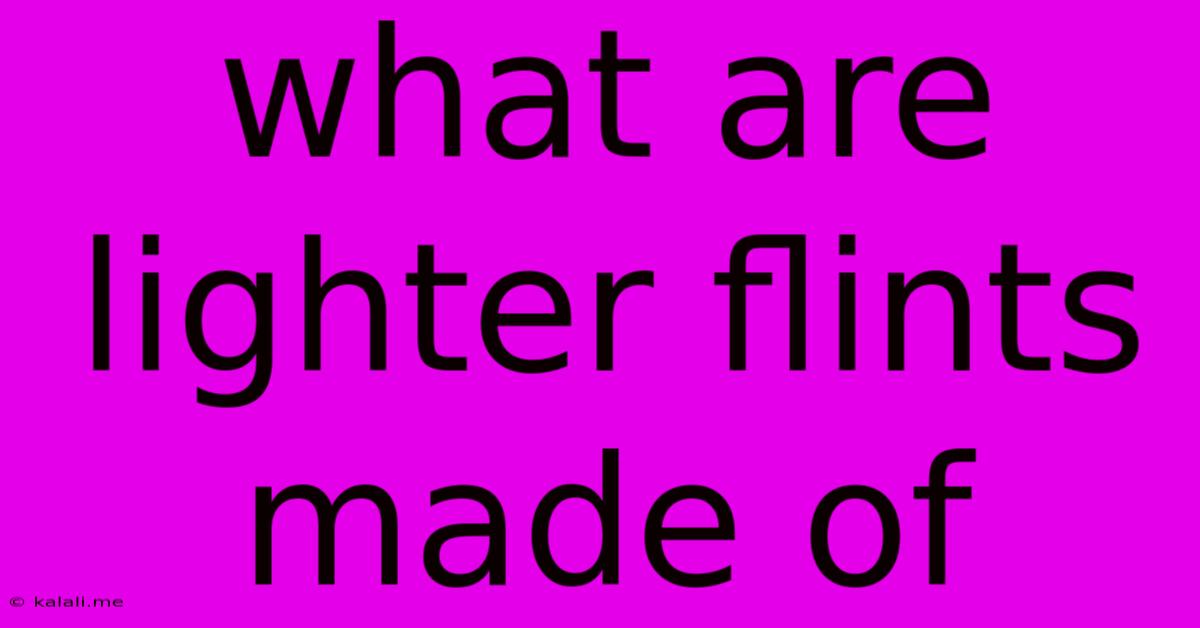What Are Lighter Flints Made Of
Kalali
May 30, 2025 · 3 min read

Table of Contents
What are Lighter Flints Made Of? The Science Behind Your Spark
Ever wondered what makes those tiny, seemingly insignificant flints in your lighter work so effectively? They're more complex than you might think! This article delves into the composition and properties of lighter flints, explaining why they're so crucial to the ignition process. Understanding their material science unlocks the magic behind creating a flame with a simple flick of the wrist.
What's the core ingredient? The answer is cerium, specifically, a cerium-iron alloy. This isn't your average metal; it's a pyrophoric alloy, meaning it readily ignites when struck. This property is key to the lighter's function. The iron acts as a binder, improving the alloy's overall strength and durability. The specific ratio of cerium to iron can vary depending on the manufacturer, influencing the flint's hardness and sparking efficiency.
Why Cerium? The Pyrophoric Advantage
Cerium's unique properties make it exceptionally suitable for lighter flints. Its high reactivity with oxygen allows for easy ignition, even with a relatively low impact from striking the flint wheel. Several key characteristics contribute to its effectiveness:
- High Reactivity: Cerium readily oxidizes (reacts with oxygen), releasing heat quickly enough to ignite the lighter's fuel.
- Low Ignition Temperature: The alloy ignites at a relatively low temperature, making ignition easy and reliable.
- Hardness and Durability: While reactive, the cerium-iron alloy is hard enough to withstand repeated strikes against the lighter's wheel without shattering easily.
The Flint Wheel: A Crucial Partner
The flint itself wouldn't create a spark without the interaction with the lighter wheel. This wheel, often made of steel, is designed with a finely textured surface. The scraping action of the wheel against the flint creates microscopic particles of the cerium-iron alloy. These particles, heated by the friction, immediately react with oxygen in the air, producing a spark hot enough to ignite the lighter's butane or other fuel.
Different Types and Qualities
While the core principle remains consistent, the quality and performance of lighter flints can differ depending on manufacturing processes and the precise alloy composition. Some flints might spark more readily, last longer, or produce a more intense spark than others. This variation can stem from differences in:
- Cerium Purity: Higher purity cerium generally results in more reliable ignition.
- Alloy Composition: The precise ratio of cerium to iron influences the flint's hardness and reactivity.
- Manufacturing Process: The manufacturing process affects the flint's density, structure, and overall durability.
Beyond the Basic Flint: Innovations and Alternatives
Although cerium-iron alloys remain the most common material for lighter flints, research continues to explore alternative materials for improving performance and sustainability. These ongoing efforts focus on developing alloys with even greater efficiency and longevity.
In conclusion, the seemingly simple lighter flint is a marvel of material science. Its effectiveness relies on the unique pyrophoric properties of cerium, skillfully combined with iron to create a robust and reliable ignition source. The interaction between the flint and the lighter wheel completes the process, resulting in the familiar spark that ignites our lighters. Understanding the science behind this small component reveals a fascinating interplay of chemistry and engineering.
Latest Posts
Latest Posts
-
Convert Fresh Basil To Dry Basil
May 31, 2025
-
Why Is James Woods In Family Guy
May 31, 2025
-
How To Abbreviate A Document Title Name
May 31, 2025
-
The Reason Is That Or Because
May 31, 2025
-
Scraping The Bottom Of The Barrel
May 31, 2025
Related Post
Thank you for visiting our website which covers about What Are Lighter Flints Made Of . We hope the information provided has been useful to you. Feel free to contact us if you have any questions or need further assistance. See you next time and don't miss to bookmark.